Schedule Tasks Menu
In the C1Schedule Tasks menu you can quickly and easily enable the Smart Designer, connect to and choose a data source, set properties, and dock the control.
To access the C1Schedule Tasks menu, click on the smart tag ( ) in the upper right corner of the control. This will open the C1Schedule Tasks menu.
) in the upper right corner of the control. This will open the C1Schedule Tasks menu.
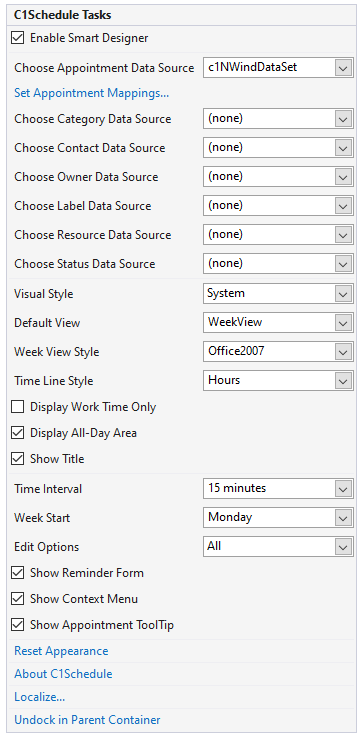
Enable Smart Designer
Selecting the Enable Smart Designer check box activates the Smart Designer on the C1Schedule control for greater design-time interaction. The default is checked. For more information on the Smart Designer, see C1Schedule Smart Designer.
Choose Appointment Data Source
Clicking the drop-down arrow in the Choose Appointment Data Source box opens a list of available data sources for the AppointmentStorage and allows you to add a new data source. To add a new data source to the project, click Add Project Data Source to open the Data Source Configuration Wizard. For more information on adding a new data source to the project, see Binding to a Data Source.
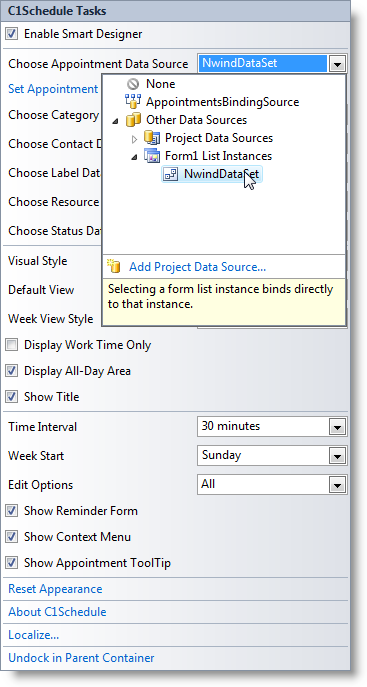
After binding to a data source, the option for data mappings will appear.
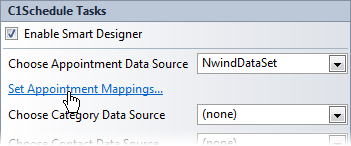
Clicking the Set Appointment Mappings link will open the Appointment Storage Properties dialog box where you can set the data mappings for the appointment data source.
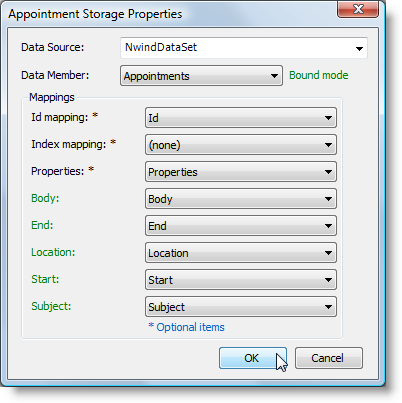
Choose Category Data Source
Clicking the drop-down arrow in the Choose Category Data Source box opens a list of available data sources for the CategoryStorage and allows you to add a new data source. After binding to a data source, the option for data mappings will appear.
Choose Contact Data Source
Clicking the drop-down arrow in the Choose Contact Data Source box opens a list of available data sources for the ContactStorage and allows you to add a new data source. After binding to a data source, the option for data mappings will appear.
Choose Owner Data Source
Clicking the drop-down arrow in the Choose Owner Data Source box opens a list of available data sources for the OwnerData and allows you to add a new data source. After binding to a data source, the option for data mappings will appear.
Choose Label Data Source
Clicking the drop-down arrow in the Choose Label Data Source box opens a list of available data sources for the LabelStorage and allows you to add a new data source. After binding to a data source, the option for data mappings will appear.
Choose Resource Data Source
Clicking the drop-down arrow in the Choose Resource Data Source box opens a list of available data sources for the ResourceStorage and allows you to add a new data source. After binding to a data source, the option for data mappings will appear.
Choose Status Data Source
Clicking the drop-down arrow in the Choose Status Data Source box opens a list of available data sources for the StatusStorage and allows you to add a new data source. After binding to a data source, the option for data mappings will appear.
Visual Style
Clicking the drop-down arrow in the Visual Style drop-down opens a list of different VisualStyle enumeration options, such as System, Office 2007 Blue, Office 2007 Black, Office 2007 Silver, Office 2010 Black, Office 2010 Silver, Office 2010 Silver, Windows XP Blue, Windows XP Silver, Windows XP Olive, Royale, Yahoo, Aero, and Custom. The default value is Office 2007 Blue. For more information on the different visual styles, see Visual Styles.
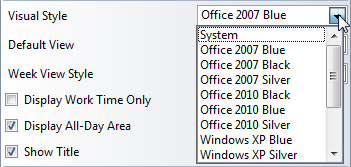
When the Visual Style drop-down is set to a modified version of one of the predefined visual styles, additional options appear in the tasks menu, such as Base Font, Bubble Look Appointments, and Title Text.
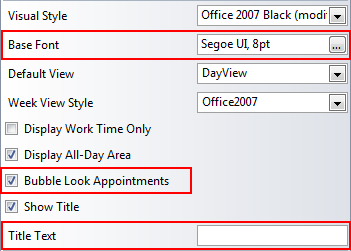
The Base Font box will open a Font dialog box where you can change the appearance of the font for the entire C1Schedule control.
The Bubble Look Appointments check box sets the BubbleLook property to show bubble appointments with a gradient background. By default, this property is set to True for Office 2007-style Visual Styles and False for other Visual Styles.
The Title Text text box sets the TitleText property, which displays a string in the title of the C1Schedule control.
Default View
Clicking the drop-down arrow in the Default View box opens a list of different ScheduleViewEnum enumeration options, such as DayView, WeekView, WorkWeekView, and MonthView. The default value is DayView. For more information on the different data views, see Data Views.
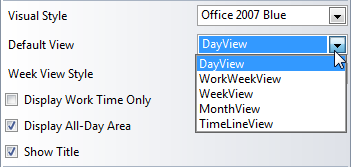
Week View Style
Clicking the drop-down arrow in the Week View Style box opens a list of different WeekViewStyleEnum enumeration options, such as Office2003 and Office2007. The default value is Office2007.
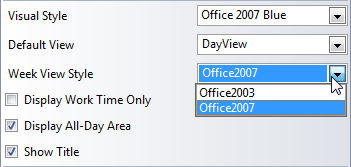
Time Line Style
Clicking the drop-down arrow in the Time Line Style box opens a list of different TimeLineStyleEnum enumeration options, such as Hours and Days. The default value is Hours.
Display Work Time Only
Checking the Display Work Time Only check box displays only the time set as work time when in DayView, WeekView, and WorkWeekView views. The default value is unchecked.
Display All-Day Area
Checking the Display All-Day Area check box displays the all-day area in the appointment. The default value is checked.
Show Title
Checking the Show Title check box sets the ShowTitle property to True and displays the title panel. The default value is checked.
Time Interval
Clicking the drop-down arrow in the Time Interval box opens a list of different TimeScaleEnum enumeration options, such as FiveMinutes, SixMinutes, TenMinutes, FifteenMinutes, TwentyMinutes, ThirtyMinutes, and OneHour. The default value is ThirtyMinutes. The TimeScaleEnum enumeration determines the time interval used for displaying time slots in the DayView, WeekView, and WorkWeekView views.
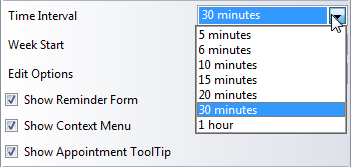
Week start
Clicking the drop-down arrow in the Week start box opens a list of different WeekStart property options, such as Sunday, Monday, Tuesday, Wednesday, Thursday, Friday, and Saturday. The default value uses the system settings. The WeekStart property determines the first day of the week.
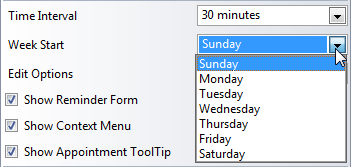
Edit Options
Clicking the drop-down arrow next to the Edit Options box opens a list of different EditOptions enumeration options, such as AllowInplaceEdit, AllowDrag, AllowAppointmentEdit, AllowAppointmentCreate, AllowAppointmentDelete, and All. The default value is All.
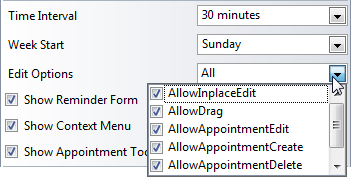
Show Reminder Form
Checking the Show Reminder Form check box sets the ShowReminderForm property to True and displays the Reminder dialog box when a reminder alerts. The default value is checked.
Show Context Menu
Checking the Show Context Menu check box sets the ShowContextMenu property to True and displays the context menu when the mouse is right-clicked. The default value is checked.
Show Appointment ToolTip
Checking the Show Appointment Tooltip check box sets the ShowAppointmentToolTip property to True and displays a ToolTip when the mouse is over an appointment. The default value is checked.
Reset Appearance
Clicking Reset Appearance resets all of the settings to the default values.
About C1Schedule
Clicking About displays the C1Schedule control's About dialog box, which is helpful in finding the build number of the control.
Localize
Clicking the Localize button opens the Localize dialog box. In the Localize dialog box, you can customize your localization settings. For more information, see Localization.
Dock in parent container/Undock in parent container
Clicking Dock in parent container sets the Dock property for C1Schedule to Fill.
If C1Schedule is docked in the parent container, the option to undock C1Schedule from the parent container will be available. Clicking Undock in parent container sets the Dock property for C1Schedule to None.
type=note
Note: WinForms .NET Edition does not include rich design-time support yet. We will enhance it in future releases.


